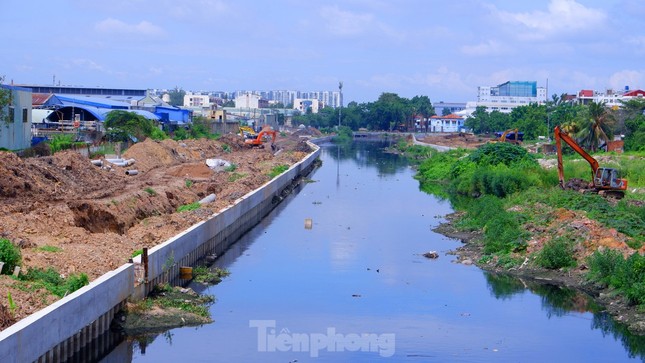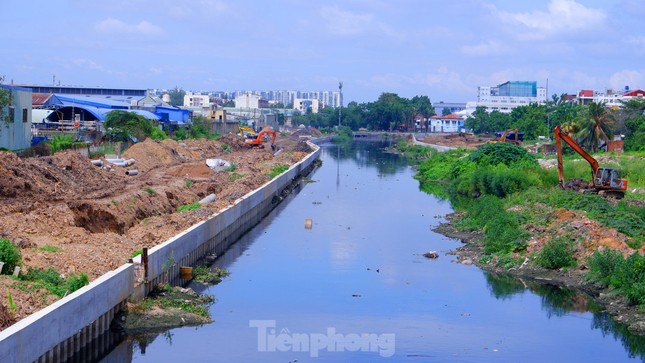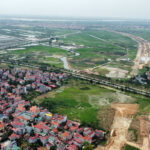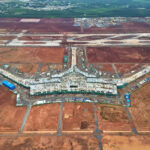The Tham Luong – Ben Cat – Rach Nuoc Len channel infrastructure development and environmental improvement project (connecting Long An province via Cho Dem river and Binh Duong and Dong Nai provinces via Saigon river) has a total investment of 8.2 trillion VND (including 4 trillion VND of central budget and 4.2 trillion VND of Ho Chi Minh City budget).
The project, which broke ground in February 2023, spans a length of nearly 32km through 7 districts and counties, including Binh Chanh district and districts 12, Binh Tan, Tan Phu, Tan Binh, Go Vap, and Binh Thanh. The main scope of the project includes dredging the channel, reinforcing concrete embankments on both sides, constructing roads with widths ranging from 7 to 12 meters along the channel, rainwater and sewage collection infrastructure, parks, and lighting systems. Ho Chi Minh City has planned to complete this project by April 30, 2025.
According to the latest report by the Ho Chi Minh City Urban Infrastructure Investment and Construction Management Board (referred to as the Urban Infrastructure Management Board) – the investor, as of now, the total construction volume of the project has reached approximately 37.90%. The project is facing several challenges and obstacles that need to be addressed promptly.

A section of the Tham Luong canal (in District 12, Ho Chi Minh City) under construction. Photo: Huu Huy
One of the major obstacles is the uncertainty regarding the disposal site for the dredged soil and sediment. According to the project’s feasibility study report, the designated disposal sites for the soil and sediment generated from the project are located in the Small Zone 3 project in Binh Tri Dong B Ward, Binh Tan District, the Go Vap Cultural Park in Ward 6, Go Vap District, and the Solid Waste Treatment Complex in Da Phuoc Ward, Binh Chanh County.
However, the investor stated that during the implementation, there was a lack of consensus from the local residents, managing agencies, and specialized departments. As a result, the soil and sediment are temporarily stockpiled at the construction site, hindering the progress of subsequent construction items and preventing the completion of inspections and capital disbursements for excavation and soil transportation tasks.
According to the project owner, the excess soil and sediment mentioned above have been determined to be non-hazardous waste. Therefore, it is proposed to utilize them for landfilling in public works managed by Ho Chi Minh City to avoid resource wastage. However, if the localities still do not have a need for this material, as has been the case recently, the Urban Infrastructure Management Board will suggest relocating it to other locations with a demand in District 12… that are managed by households willing to receive it after coordinating with specialized departments, professional agencies, and local authorities to complete the necessary procedures.
Additionally, the project is facing challenges due to re-encroachment by households within the compensated and resettled scope in phase 1 (including 21 cases: 1 case in Binh Thanh District, 2 cases in District 12, 1 case in Go Vap District, 15 cases in Binh Tan District, and 2 cases in Binh Chanh County).
The investor proposes that the People’s Committees of the localities coordinate in propagating, mobilizing, or planning to dismantle, retrieve, and hand over the site to ensure the construction progress.
Apart from the aforementioned issues, the project owner also mentioned difficulties in adjusting and supplementing certain items due to the complex geology and inadequate traffic connectivity. This requires modifications to some items to align with the actual conditions. However, the project’s contingency fund is insufficient to cover the implementation of the subsequent steps.
Currently, some of the adjusted and supplemented items have been completed by the contractors but cannot be inspected and paid for. The investor is in the process of compiling and categorizing the documents and will approve the items within their authority.
Furthermore, the project faces challenges in procuring construction materials such as fill sand and rocks, and the market prices for these materials are higher than the contracted prices of the contractors. This situation puts the construction contractors in a financially disadvantageous position, leading to financial imbalances during the construction process and causing delays in progress.
Given these challenges, the investor is in the process of compiling and categorizing the specific difficulties and will report to the competent authorities for guidance and directions.
Regarding the disbursement of public investment capital for the project, the investor estimates that the disbursement will reach 1,028/3,400 billion VND, or 30.23% (including 789.183/1,500 billion VND of central budget and 238.817/1,900 billion VND of city budget) provided that the obstacle regarding the soil and sediment reception site is resolved by November 2024.
The Rising Demand for Residential Properties Among Professionals in Binh Duong: Drivers and Forecasts
“The robust growth of industrial parks and foreign investment in Binh Duong has led to a sharp rise in housing demand from professionals. “
Mobilizing Over 6,500 Workers and 2,200 Equipment, Most Transport Projects in the Mekong Delta Are Still Delayed by 4-15% Due to One Main Reason
The Mekong Delta region is currently undertaking 9 critical national transportation projects with a total investment of 106,000 billion VND. 8 out of 9 projects are under active construction, while the My An – Cao Lanh Expressway project, funded by Korean ODA, is finalizing procedures and is expected to break ground in early 2025.
The New Auctioned Land in Hanoi: A Post-Cancellation Opportunity?
The 32 land lots offered by Me Linh District, Hanoi, for auction witnessed a thrilling bidding war, with the highest successful bid reaching an impressive 48.9 million VND per square meter, almost double the starting price. The intense interest in these lots is a testament to their desirability, with even the lowest successful bid standing at a substantial 33.3 million VND per square meter.
Racing with the Long Thanh Airport City
The southern province of Dong Nai is gearing up to maximize the advantages brought by the upcoming Long Thanh International Airport. With the first phase of the airport expected to be operational by September 2026, the province is working diligently to ensure it is well-prepared to capitalize on the opportunities that this major infrastructure project will bring.





















